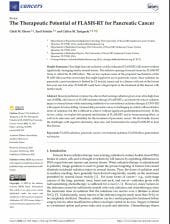Ultra-high dose rate radiation, widely nicknamed FLASH-RT, kills tumors without
significantly damaging nearby normal tissues. This selective sparing of normal tissue by FLASH-RT
tissue is called the FLASH effect. This review explores some of the proposed mechanisms of the
FLASH effect and the current data that might support its use in pancreatic cancer. Since radiation for
pancreatic cancer treatment is limited by GI toxicity issues and is a disease with one of the lowest
five-year survival rates, FLASH-RT could have a large impact in the treatment of this disease with
further study.
